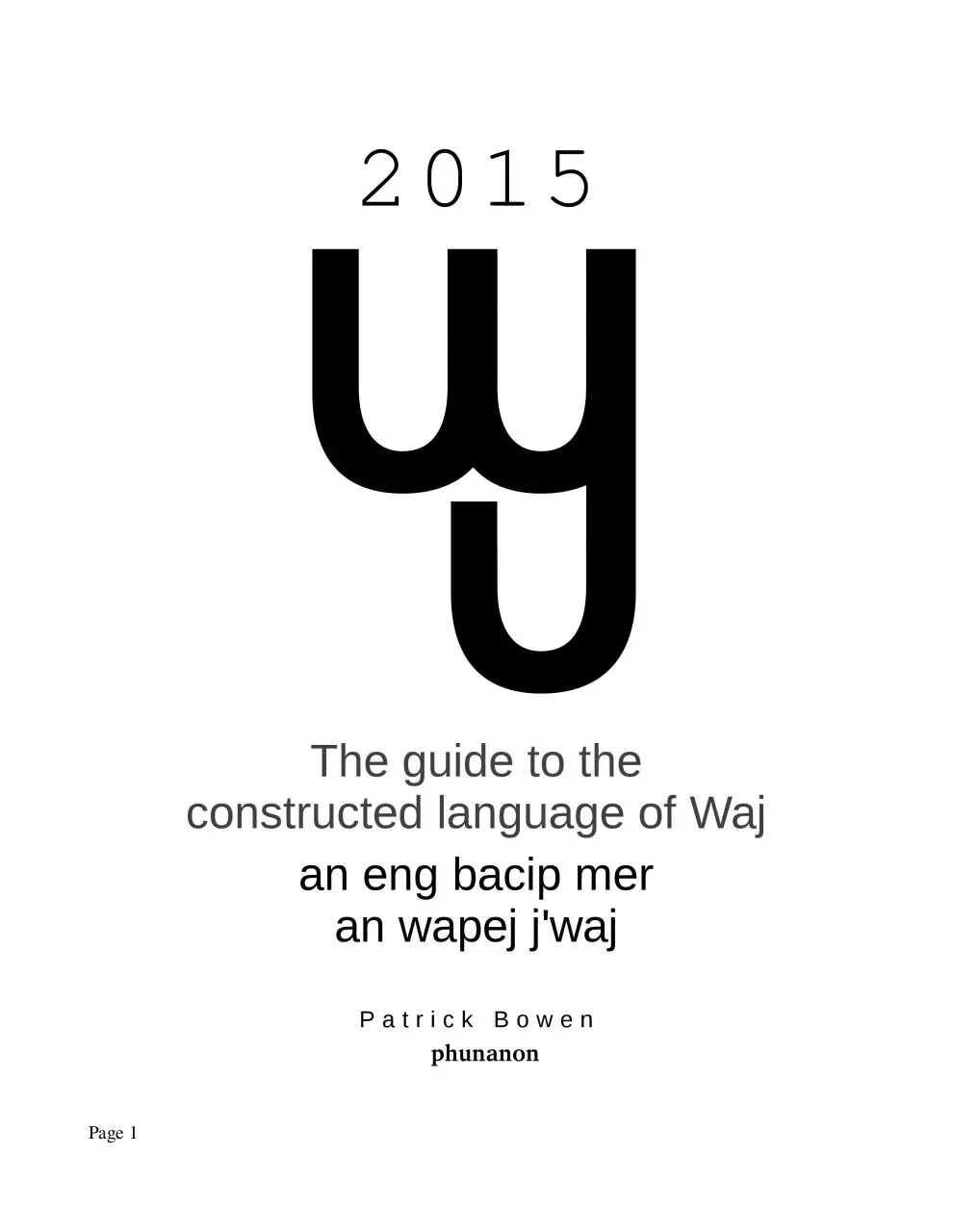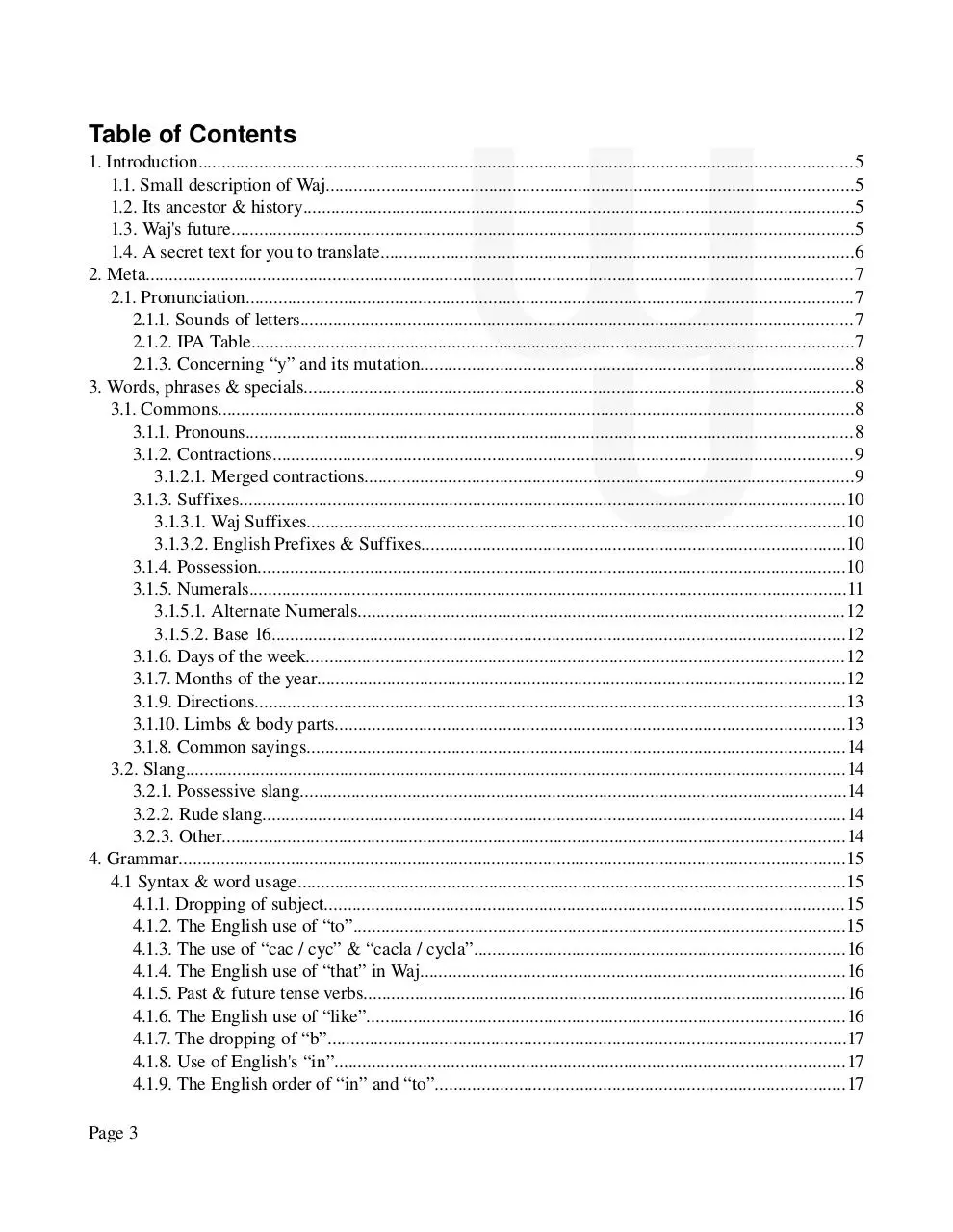TEGTW (PDF)
File information
This PDF 1.4 document has been generated by Writer / LibreOffice 3.5, and has been sent on pdf-archive.com on 09/11/2014 at 05:32, from IP address 87.113.x.x.
The current document download page has been viewed 3871 times.
File size: 1.25 MB (151 pages).
Privacy: public file





File preview
Page 1
Thanks to Reddit use rs
Snuggle_Moose and most especially purpleice822
For being such hilarious human beings ;D
Page 2
Table of Contents
1. Introduction............................................................................................................................................5
1.1. Small description of Waj.................................................................................................................5
1.2. Its ancestor & history......................................................................................................................5
1.3. Waj's future.....................................................................................................................................5
1.4. A secret text for you to translate.....................................................................................................6
2. Meta.......................................................................................................................................................7
2.1. Pronunciation..................................................................................................................................7
2.1.1. Sounds of letters......................................................................................................................7
2.1.2. IPA Table.................................................................................................................................7
2.1.3. Concerning “y” and its mutation.............................................................................................8
3. Words, phrases & specials......................................................................................................................8
3.1. Commons........................................................................................................................................8
3.1.1. Pronouns..................................................................................................................................8
3.1.2. Contractions............................................................................................................................9
3.1.2.1. Merged contractions.........................................................................................................9
3.1.3. Suffixes..................................................................................................................................10
3.1.3.1. Waj Suffixes...................................................................................................................10
3.1.3.2. English Prefixes & Suffixes...........................................................................................10
3.1.4. Possession..............................................................................................................................10
3.1.5. Numerals................................................................................................................................11
3.1.5.1. Alternate Numerals........................................................................................................12
3.1.5.2. Base 16...........................................................................................................................12
3.1.6. Days of the week...................................................................................................................12
3.1.7. Months of the year.................................................................................................................12
3.1.9. Directions..............................................................................................................................13
3.1.10. Limbs & body parts.............................................................................................................13
3.1.8. Common sayings...................................................................................................................14
3.2. Slang.............................................................................................................................................14
3.2.1. Possessive slang.....................................................................................................................14
3.2.2. Rude slang.............................................................................................................................14
3.2.3. Other.....................................................................................................................................14
4. Grammar...............................................................................................................................................15
4.1 Syntax & word usage.....................................................................................................................15
4.1.1. Dropping of subject...............................................................................................................15
4.1.2. The English use of “to”.........................................................................................................15
4.1.3. The use of “cac / cyc” & “cacla / cycla”...............................................................................16
4.1.4. The English use of “that” in Waj...........................................................................................16
4.1.5. Past & future tense verbs.......................................................................................................16
4.1.6. The English use of “like”......................................................................................................16
4.1.7. The dropping of “b”...............................................................................................................17
4.1.8. Use of English's “in”.............................................................................................................17
4.1.9. The English order of “in” and “to”........................................................................................17
Page 3
4.1.10. English's “changed to”.........................................................................................................17
4.1.11. English's s suffix as a third person singular present...........................................................17
4.1.12. “b” ending a sentence..........................................................................................................18
4.1.13. Concerning English's “I have done” & “I have to”..............................................................18
4.1.14. Concerning “geo” and “geale”.............................................................................................18
4.1.15. The use of “loth” & “losh”................................................................................................18
4.1.16. Concerning events done regularly in the past......................................................................19
4.1.17. The use of “uth”..................................................................................................................19
4.1.18. Concerning “il” & “ip”........................................................................................................19
4.1.19. Concerning Waj's plurals, somes, and alls...........................................................................19
4.1.20. Concerning “ap” & “aap”....................................................................................................19
4.1.21. The use of English's “what”.................................................................................................20
4.1.22. The use of English's “why”.................................................................................................20
4.1.23. The use of English's “that” and “which”.............................................................................20
4.1.24. Acting upon an object.........................................................................................................20
4.1.25. English's “would” and “could”............................................................................................20
4.1.26. Telling and talking...............................................................................................................20
4.1.27. Waj's “git” and “yipa”..........................................................................................................20
4.1.28. English's “one”....................................................................................................................21
4.1.29. Referencing people by amount............................................................................................21
4.1.30. English's “mine”..................................................................................................................21
4.1.31. Moods..................................................................................................................................21
4.1.32. Commanding others........................................................................................................21
4.1.33. English's “as...as”................................................................................................................22
4.1.34. Nouns as verbs.....................................................................................................................22
4.1.35. Waj's “re”.............................................................................................................................22
4.2. Formality......................................................................................................................................22
5. Writing and other documenting...........................................................................................................23
5.1. In all forms....................................................................................................................................23
5.1. Alphabets & scripts.......................................................................................................................23
5.1.1. Common Alphabet.................................................................................................................23
5.1.2. gasyan amej...........................................................................................................................24
5.1.3. hqal........................................................................................................................................25
6. Dictionary.............................................................................................................................................26
6.1. Waj to English...............................................................................................................................27
6.2. English to Waj..............................................................................................................................83
Page 4
1. Introduction
1.1. Small description of Waj
Waj is a constructed language (conlang), created and developed from 2013 to 2014 hej libi by
myself, Patrick Bowen, in an attempt to make a easy to use and remember language. Over the
years of its development, it has gone through a lot of changes, but has always remained the
langauage of which I reveer as me. It's the first and currently last effort of mine to create a
fully functioning language, and its start was simply me playing around.
I have to give many thanks to /r/conlangs on Reddit.com for all their goals and interests, and
for making me feel included and known within their community, though, as this document
shows, I am a terrible excuse of a conlanger.
1.2. Its ancestor & history
Waj, in its early stages, was called “Rhohine,” and was a complete mess of a language; using
English spelling, with no actual goal or purpose, it was only saved by the fact I realised early
on that I controlled a language and its development, and I'm enjoying myself. Soon, after words
such as shkafshka for you had been shortened, and I realised English has a lot of words which
mean multiple things, and how you needed auxilary verbs and used irregular nouns, my
tinkering increased.
It was, as I thought then, rather late when I was Googling about something to do with Klingon
or Esporanto and I stumbled upon Reddit and its online Conlanging community “I'm not the
only one!” Their posts and challenges pushed me to start doing long translations, testing out
types of sentences I never gave thought to. Seeing other peoples' prejects develop with things I
thought, “if I was making another language, I'd do that,” but instead it made me put a tighter
hold on Waj – making it smaller and more efficient. Something which has played a great part
in making Waj was also making an online translator created alongside it. The program
stretched my coding skills as it did Waj, while it also making the language extremely easy for a
computer to translate. (English to Waj is a lot more difficult than Waj to English).
1.3. Waj's future
Sadly, Waj has no future. As of November 2014, Waj shall cease to have any work put
towards it from me. As a conlanger, I have come to realise that I can do far better at achieving
my personal goal of having a small, goodlooking conlang. My next project, zaz, shall include
things like tone and defined word structure. It is a shame that Waj has to end, after years of its
development and use by me, but to make a good progress, I have to move on. Of course, I
don't fully control its future – anybody who reads this (especially in this amount of depth)
could take it upon theirself to use or even take this project and somehow add on it.
Page 5
1.4. A secret text for you to translate
an c'caji j'waj the big secret of Waj...
a catca waj ligri eca bai opith jay de bleta. an boty wan git eca ner jay cycla yiple. sha
nercth wajli re de pati ed sha retac ip. bli, neric sha upa, ju sha wapic il sha jep a
jefag.
juth, mati hej jep ap jefag illa jen. tery an caji:
waj o'ligryli op a yca tata. il bth jit r'Rhohine. “waj” rantic tata “waply geju ju.”
“urpt” ap “ud” a “u” git lyc illa, aap an “d” lyci g'ligrala bana “dweci,” “dyc” c'jajy lyc
j'blo r'a teryp, jud dyplo. “o” tqd rahu op lyc g'leo. “opec,” “opeci,” “op,” “opic,” mati
an lycila? shcafa il. aap, flenc sha shcafi waj!
Page 6
2. Meta
2.1. Pronunciation
2.1.1. Sounds of letters
The sounds of all the letters in Waj are wrote to be phonetically equivilent, but of course,
malformation can occur when spoken. It is up to the speaker how exactly they pronounce
things, so long as it would be understandable to their peers.
2.1.2. IPA Table
Latin script
IPA
Spoken like...
Latin script
IPA
Spoken like...
A
a
/a/
cat
P
p
/p/
pat
B
b
/b/
bat
Q
q
/ ɒ/
orange
C
c
/k/
cat
R
r
/ɾ/
rate (spoken with a tap)
D
d
/d/
dog
S
s
/s/
sit
E
e
/ɛ/
bet
T
t
/t/
tap
F
f
/f/
frog
U
u
/ʌ/
hug
G
g
/ɡ/
goat
W
w
/w/
wait
H
h
/h/
hat
Y
y
/ɪ/
bit
I
i
/aj/
high
TH
th
/θ/
thank
J
j
/ʒ/
vision
SH
sh
/ʃ/
shake
L
l
/l/
log
AY
ay
/eɪ/
pay
M
m
/m/
mat
EE
ee
/iː/
bee
N
n
/n/
note
OO
oo
/u:/
true
O
o
/o:/
oat
AA
aa
/a:/
Slightly long a
Page 7
2.1.3. Concerning “y” and its mutation
It is common, especially for people whom use /j/ (yolk) in every day speech, to pronounce y as
such. However, it is only really accepted with major Waj speakers if this mutation precedes
a /ə/ sound or, less acceptedly, a /aj/ sound.
An example of this is the word yawfi, which some might pronounce /jəwfaj/ or /ɪjəwfaj/
instead of /ɪəwfaj/.
3. Words, phrases & specials
3.1. Commons
3.1.1. Pronouns
de: Used like English's I; it is to address oneself.
sha: Used like English's you; it is to address the listener. This can be made plural for more than
one listener.
she: Used near to English's us & we; it is to address oneself and others which one is with at the
time; an inclusive.
pe: Used near to English's us & we; it is to address oneself and others which one is associated;
an exclusive.
ma: Used like English's she & her; it is used to reference a female object / person. Can be
plural.
da: Used like English's he, his & him; it is used to reference a male object / person. Can be
plural.
dma: Used like English's they & them; used to reference multiple people of multiple genders.
sada: It is used to reference a object / person of unknown gender.
ip: Used like English's that & it; used to identify to a specific person or thing previously
mentioned, being observed or easily identified.
il: Used like English's this; used to identify a specific thing close at hand or being indicated or
experienced.
is: a word refering to the conversation topic, in general.
ipla: Used like English's those; the plural form of ip.
illa Used like English's these; the plural form of il.
Page 8
3.1.2. Contractions
Contractions are letters that are added onto the front of a word, or between two words. All it is
is a shortened word that, when wrote, is “[contraction]'[word].” The apostrophes are spoken
like the hyphen in uhoh.
'a', the English and, Waj's ap. Only used if to not be confused with a.
b', the English be/is/am/are, Waj's b.
f', the English good, Waj's fleen.
o', used for possession.
j', the English of, Waj's jup.
c', the English big/very/much, Waj's cac.
g', the English with, Waj's grap.
n', the English no/not, Waj's ne.
r', the English in, Waj's ra.
h', the English to/toward/towards, Waj's he.
3.1.2.1. Merged contractions
Sometimes, contractions are spoken as part of the word they are attached to—called a morph.
This is especially common with words starting with a vowel. Here is a table with a few of the
possibilities:
Contraction
Word
The morph
b'
a
ba
be a
a standard
j'
an
jan
of the
accepted
b'
an
ban
be the
accepted
h'
an
han
towards the
accepted
r'
an
ran
in the
accepted
f' (abstract)
eci
ecif
best
a standard
f' (abstract)
ecac
ecacf
better
a standard
Page 9
Meaning
Usage
Download TEGTW
TEGTW.pdf (PDF, 1.25 MB)
Download PDF
Share this file on social networks
Link to this page
Permanent link
Use the permanent link to the download page to share your document on Facebook, Twitter, LinkedIn, or directly with a contact by e-Mail, Messenger, Whatsapp, Line..
Short link
Use the short link to share your document on Twitter or by text message (SMS)
HTML Code
Copy the following HTML code to share your document on a Website or Blog
QR Code to this page

This file has been shared publicly by a user of PDF Archive.
Document ID: 0000193156.